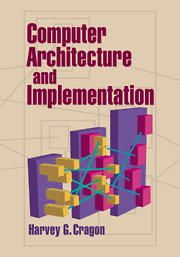Preface
Published online by Cambridge University Press: 05 June 2012
Summary
This textbook is intended for use in a one-semester, upper-division undergraduate course. It is expected that the students will have had courses in logic design with state machines and assembly language programming. A course in data structures as well as basic operating systems would be helpful.
There are two major themes running through this book. The first theme is an overview of the major ideas and design philosophies of computer architecture and implementation with some insight into their historical development. We are inclined to forget the work of our predecessors in computer design; the few pages devoted to this topic may help to rectify this neglect.
The second theme is the introduction and use of analytic modeling of computer performance. I believe that engineering students should take an engineering approach to the study of computer architecture and implementation. Various design trade-off issues will be examined with analytical models. What is an engineering approach? Consider the following two quotations.
“What distinguished the engineer from the technician is largely the ability to formulate and carry out the detailed calculations of forces and deflections, concentrations and flows, voltages and currents, that are required to test a proposed design on paper with regard to failure criteria. The ability to calculate is the ability to predict the performance of a design before it is built and tested.” (Petroske 1996).
“… it is much easier to have some vague notion about any subject, no matter what, than to arrive at the real truth about a single question, however simple that may be.” (Descartes 1629).
- Type
- Chapter
- Information
- Computer Architecture and Implementation , pp. viii - xPublisher: Cambridge University PressPrint publication year: 2000

